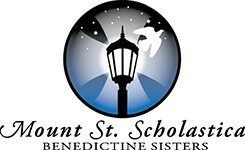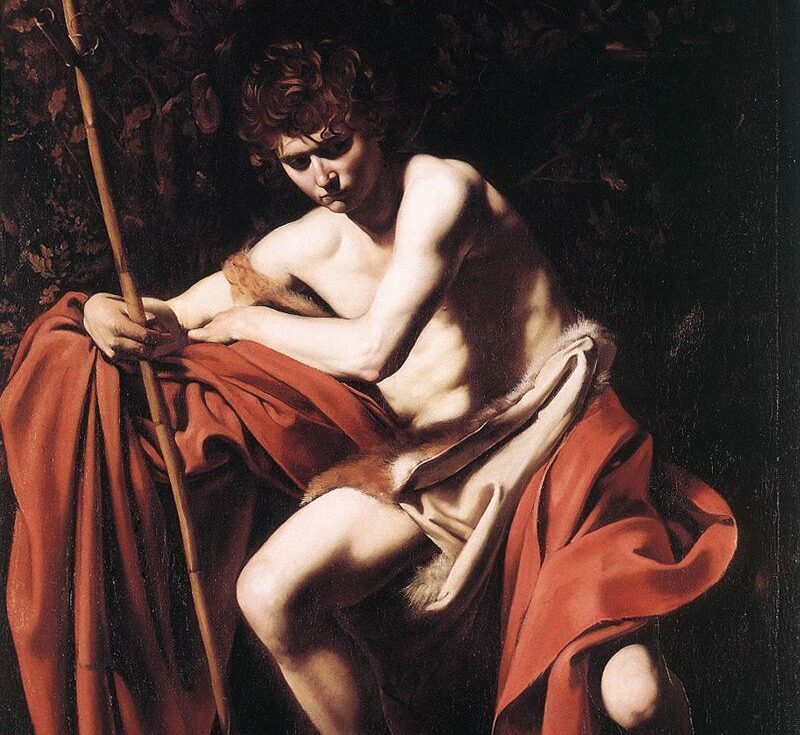Sr. Therese Elias, OSB | June 23, 2023
There’s a magnificent painting of John the Baptist at the Nelson Art Gallery in Kansas City. It’s among their most valuable art pieces. The painting by Italian artist Caravaggio is world famous and the occasion for pilgrimages by art lovers from across the world, who come to the Nelson just to sit in its presence. Caravaggio was completely taken with the story of John and created multiple paintings of him. He was attracted, I think, by some of the themes in the Gospel for this feast.
Given what we know about John from Scripture, no one who knew his family would have seen him as an ordinary child. His father, Zechariah, as a temple priest, was prominent, which means the ceremony of John’s Circumcision would have been well attended. Nine months before this, worshippers had observed Zechariah being struck mute while serving in the temple. In the Scripture preceding the Gospel we heard this evening, Luke tells us this happened because Zechariah had doubted the angel’s word that he and Elizabeth would have this baby at their advanced age. And here, at his Circumcision, his father – after concurring that his name will be “John” is suddenly freed from his inability to speak. And he prays over the child, in the Canticle we Benedictines sing every morning: “You, child, will be a prophet of the Most High. You will go before the face of the Lord to prepare the way.”
The Gospel goes on to say, “All in their company were afraid” and, not only those in attendance but, it says, “these matters were discussed all through the countryside.” What would it be like to grow up with this kind of attention? “What, then, will this child be?” they ask and you can imagine how they might have observed him in awe when they saw him out and about. “Surely the hand of the Lord is with him.”
Caravaggio captures the John who would have been affected by these momentous events. With his artful use of light and shadow, the painter shows us a pensive, brooding young man, with shadowed eyes gazing into the distance. He has his staff in his hand as if preparing for the next move into the rest of his life, whatever that might be. We can imagine John, in his youth, pondering, perhaps even struggling, with his identity and the significance of this mysterious call that had come to him. He might have prayed that this “chalice be taken away.”
At the same time, this painting shows John as a resolute young man with a firm sense of purpose and a strong sense of self. John had met Jesus when they were both in their mothers’ wombs. We know from the section of the Gospel that precedes this, that Mary journeyed to visit Elizabeth and when they embraced, John leapt in his mother’s womb. John had been touched by the divine. He had been grasped by God as a special child with a special purpose. “Surely, the hand of the Lord is with him.”
We celebrate the feasts of the saints because they played an important role in the coming of the reign of God. But that’s not the only reason. They are there as models, meaning, that what’s true of them, is true of us. Each of us, like John, has been touched by God. You have met Christ. You know in your deepest heart of hearts, that you are the “beloved,” that God loves you in a deeply personal way. You know too, that you have a special role in spreading the Gospel, a role so unique that only you can accomplish it.
What is said of John can be said of us. In tomorrow’s Eucharist, we’ll hear the Scripture from Isaiah: “The Lord called me from birth, from my mother’s womb, God gave me my name.” I would invite you sometime in the next day or so to read Isaiah 49, to ponder these words and let them penetrate your consciousness: “The Lord called me from birth, from my mother’s womb, God gave me my name.”
This feast reminds us so clearly how deeply each of us is cherished by God. Every atom of your being is alight with the love of God. The mystics tell us that love is so essential to our being that, if God were to stop loving you, you would disappear. We’d see you sitting there in your stall, look again and ‘Phfft!’ suddenly you’d be gone!
Tomorrow’s Eucharistic readings are unimaginably rich. The Responsorial Psalm is from Psalm 139: “You search me, Lord, and you know me. Wherever I walk or rest, you know where I have been. You created every part of me, knitting me in my mother’s womb. Awesome this wonder. I see it so clearly!” Awesome! (Can you imagine God looking at you and saying, “Ooh! Awesome!”)
Our part of praying this psalm will be to repeat after the cantor: “I praise you for I am wonderfully made.” (Another reading to spend time with. . .) And then there’s the line that may really catch our attention, “I praise you that I am ‘fearfully,’ wonderfully made!”
Perhaps this solemn Feast of the Nativity of John the Baptist is an occasion for us to celebrate our own goodness, the goodness that is given by a God who loves us with passion. It’s also a time to be grateful for our call, like John’s, to serve the reign of God. “Awesome this wonder!”


Comments are closed